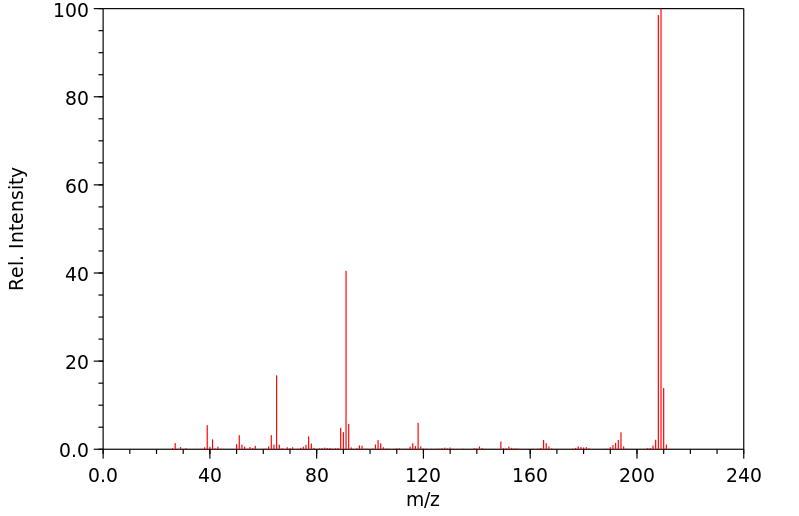N-(4-methylbenzylidene)-4-methylaniline | 16979-20-7
中文名称
——
中文别名
——
英文名称
N-(4-methylbenzylidene)-4-methylaniline
英文别名
4-methyl-N-(4-methylbenzylidene)aniline;N-(p-Methylbenzyliden)-p-methylanilin;N,1-di-p-tolylmethanimine;N-<4-Methyl-benzyliden>-p-toluidin;4-Methylbenzylidene-4-methylaniline;N,1-bis(4-methylphenyl)methanimine
CAS
16979-20-7
化学式
C15H15N
mdl
MFCD00025978
分子量
209.291
InChiKey
LKMIOABGTREIHR-UHFFFAOYSA-N
BEILSTEIN
——
EINECS
——
-
物化性质
-
计算性质
-
ADMET
-
安全信息
-
SDS
-
制备方法与用途
-
上下游信息
-
文献信息
-
表征谱图
-
同类化合物
-
相关功能分类
-
相关结构分类
物化性质
-
保留指数:1998
计算性质
-
辛醇/水分配系数(LogP):3.5
-
重原子数:16
-
可旋转键数:2
-
环数:2.0
-
sp3杂化的碳原子比例:0.13
-
拓扑面积:12.4
-
氢给体数:0
-
氢受体数:1
反应信息
-
作为反应物:描述:N-(4-methylbenzylidene)-4-methylaniline 在 三氟甲磺酸 、 重水 、 双三氟甲烷磺酰亚胺银盐 作用下, 以 氘代二甲亚砜 、 甲苯 为溶剂, 反应 27.0h, 生成 6-methyl-2-(p-tolyl)quinoline参考文献:名称:Silver-Mediated C–H Activation: Oxidative Coupling/Cyclization of N-Arylimines and Alkynes for the Synthesis of Quinolines摘要:A silver-mediated tandem protocol for the synthesis of quinolines involving the oxidative coupling/cyclization of N-arylimines and alkynes has been developed. We demonstrated that scenario-dependent metalation could occur either at the ortho C-H bond of an N-arylimine through protonation-driven enhancement of acidity or at the terminal C-H bond of an alkyne by virtue of the carbophilic pi-acidity of silver. The diverse set of mechanistic manifolds implemented with a single type of experimental protocol points toward the importance of stringent reactivity analysis of each individual potentially reactive molecular site. Importantly, the direct arene C H bond activation provides a unique and distinct mechanistic handle for the expansion of reactivity paradigms for silver. As expected, the protocol allows for the incorporation of both internal and terminal alkynes into the products, and in addition, both electron-withdrawing and -donating groups are tolerated on N-arylimines, thus enabling the vast expansion of substituent architectures on quinoline framework. Further, an intriguing phenomenon of structural isomerization and chemical bond cleavage has been observed for aliphatic internal alkynes.DOI:10.1021/jo202087j
-
作为产物:描述:对甲基苯甲醛 在 ammonium acetate 作用下, 以 甲醇 、 溶剂黄146 为溶剂, 反应 4.0h, 生成 N-(4-methylbenzylidene)-4-methylaniline参考文献:名称:胺和肼向硝基苯乙烯的迈克尔加成反应的机理研究:通过逆转氮杂亨利型方法消除硝基烷摘要:在本文中,我们报告了将胺和肼加成至硝基苯乙烯的机理研究。在当前条件下,通过逆转氮杂亨利型方法观察到了相应的N-烷基/芳基取代的苄基亚胺和N-甲基/苯基取代的苄基hydr。通过将有机合成和表征实验与计算化学计算相结合,我们揭示了该反应是通过质子溶剂介导的机理进行的。氘代甲醇CD 3的实验OD揭示了相应的氘代中间体迈克尔加合物的合成和分离,结果支持所提出的slovent介导的途径。从合成的观点来看,该反应在温和的非催化条件下进行,可以用作一锅法以生物学上重要的N-甲基吡唑的有用平台,简单地从相应的硝基苯乙烯和甲基肼开始。DOI:10.1021/acs.joc.7b02637
-
作为试剂:描述:参考文献:名称:铁,铑和铱的4,5-苯甲酮π配合物的合成及其在催化借位-氢反应中的潜在用途摘要:报道了带有4,5-二苯甲酮配体的铑,铱和铁π配合物的合成。X射线结晶分析表明环庚三烯酮芯坐标到金属中心的η 4与桶形式的几何形状的方式。某些苯甲酮π配合物通过借入氢对苯胺的N-烷基化表现出催化活性。DOI:10.1021/acs.inorgchem.0c03587
文献信息
-
One-Pot Catalytic Approach for the Selective Aerobic Synthesis of Imines from Alcohols and Amines Using Efficient Arene Diruthenium(II) Catalysts under Mild Conditions作者:Sundar Saranya、Rengan Ramesh、Jan Grzegorz MałeckiDOI:10.1002/ejoc.201701408日期:2017.12.8A green and efficient catalytic approach for the selective synthesis of imines in air at room temperature was achieved with the aid of newly synthesised diruthenium(II) complexes [(η6-p-cymene)2Ru2Cl2(µ-L)] containing substituted 1,2-diacylhydrazine ligands. All the new complexes were fully characterised by analytical and spectroscopic techniques. The solid-state structure of a representative complex
-
Phosphine ligand-free RuCl3-catalyzed reductive N-alkylation of aryl nitro compounds作者:Da-Wei Tan、Hong-Xi Li、David James Young、Jian-Ping LangDOI:10.1016/j.tet.2016.05.036日期:2016.7efficiently catalyses the reductive N-alkylation of aryl nitro compounds with alcohols using bio-based glycerol as the hydrogen source and without the need for any added solvents. The reaction can be easily manipulated to produce either imines or secondary amines in high yields. RuCl3-catalyzed reductive N-alkylation of nitroarenes with alcohols affords the corresponding imine products in good to excellent
-
Direct synthesis of imines by 9-azabicyclo-[3,3,1]nonan-N-oxyl/KOH-catalyzed aerobic oxidative coupling of alcohols and amines作者:Yan Wan、Jia-Qi Ma、Chao Hong、Mei-Chao Li、Li-Qun Jin、Xin-Quan Hu、Bao-Xiang Hu、Wei-Min Mo、Nan Sun、Zhen-Lu ShenDOI:10.1016/j.cclet.2017.10.006日期:2018.8Abstract A simple and efficient method for preparation of imines by the oxidative coupling of benzyl alcohols with aromatic amines or aliphatic amines was developed. The reaction was catalyzed by 9-azabicyclo[3.3.1]nonan-N-oxyl (ABNO)/KOH with air as the economic and green oxidant. Under the optimal reaction conditions, a variety of imines were obtained in 80%-96% isolated yields.
-
Dual Heterogeneous Catalyst Pd–Au@Mn(II)-MOF for One-Pot Tandem Synthesis of Imines from Alcohols and Amines作者:Gong-Jun Chen、Hui-Chao Ma、Wen-Ling Xin、Xiao-Bo Li、Fa-Zheng Jin、Jing-Si Wang、Ming-Yang Liu、Yu-Bin DongDOI:10.1021/acs.inorgchem.6b02592日期:2017.1.3A new Mn(II) metal–organic framework (MOF) 1 was synthesized by the combination of 4,4,4-trifluoro-1-(4-(pyridin-4-yl)phenyl)butane-1,3-dione (L) and Mn(OAc)2 in solution. 1 features a threefold-interpenetrating NbO net containing honeycomb-like channels, in which the opposite Mn(II)···Mn(II) distance is 23.5075(10) Å. Furthermore, 1 can be an ideal platform to support Pd–Au bimetallic alloy nanoparticles
-
Visible-Light Photocatalytic Synthesis of Amines from Imines via Transfer Hydrogenation Using Quantum Dots as Catalysts作者:Zi-Wei Xi、Lei Yang、Dan-Yan Wang、Chao-Dan Pu、Yong-Miao Shen、Chuan-De Wu、Xiao-Gang PengDOI:10.1021/acs.joc.8b01651日期:2018.10.5core/shell quantum dots (QDs) can be used as stable and highly active photoredox catalysts for efficient transfer hydrogenation of imines to amines with thiophenol as a hydrogen atom donor. This reaction proceeds via a proton-coupled electron transfer (PCET) from the QDs conduction band to the protonated imine followed by hydrogen atom transfer from the thiophenol to the α-aminoalkyl radical. This precious
表征谱图
-
氢谱1HNMR
-
质谱MS
-
碳谱13CNMR
-
红外IR
-
拉曼Raman
-
峰位数据
-
峰位匹配
-
表征信息
同类化合物
(βS)-β-氨基-4-(4-羟基苯氧基)-3,5-二碘苯甲丙醇
(S,S)-邻甲苯基-DIPAMP
(S)-(-)-7'-〔4(S)-(苄基)恶唑-2-基]-7-二(3,5-二-叔丁基苯基)膦基-2,2',3,3'-四氢-1,1-螺二氢茚
(S)-盐酸沙丁胺醇
(S)-3-(叔丁基)-4-(2,6-二甲氧基苯基)-2,3-二氢苯并[d][1,3]氧磷杂环戊二烯
(S)-2,2'-双[双(3,5-三氟甲基苯基)膦基]-4,4',6,6'-四甲氧基联苯
(S)-1-[3,5-双(三氟甲基)苯基]-3-[1-(二甲基氨基)-3-甲基丁烷-2-基]硫脲
(R)富马酸托特罗定
(R)-(-)-盐酸尼古地平
(R)-(-)-4,12-双(二苯基膦基)[2.2]对环芳烷(1,5环辛二烯)铑(I)四氟硼酸盐
(R)-(+)-7-双(3,5-二叔丁基苯基)膦基7''-[((6-甲基吡啶-2-基甲基)氨基]-2,2'',3,3''-四氢-1,1''-螺双茚满
(R)-(+)-7-双(3,5-二叔丁基苯基)膦基7''-[(4-叔丁基吡啶-2-基甲基)氨基]-2,2'',3,3''-四氢-1,1''-螺双茚满
(R)-(+)-7-双(3,5-二叔丁基苯基)膦基7''-[(3-甲基吡啶-2-基甲基)氨基]-2,2'',3,3''-四氢-1,1''-螺双茚满
(R)-(+)-4,7-双(3,5-二-叔丁基苯基)膦基-7“-[(吡啶-2-基甲基)氨基]-2,2”,3,3'-四氢1,1'-螺二茚满
(R)-3-(叔丁基)-4-(2,6-二苯氧基苯基)-2,3-二氢苯并[d][1,3]氧杂磷杂环戊烯
(R)-2-[((二苯基膦基)甲基]吡咯烷
(R)-1-[3,5-双(三氟甲基)苯基]-3-[1-(二甲基氨基)-3-甲基丁烷-2-基]硫脲
(N-(4-甲氧基苯基)-N-甲基-3-(1-哌啶基)丙-2-烯酰胺)
(5-溴-2-羟基苯基)-4-氯苯甲酮
(5-溴-2-氯苯基)(4-羟基苯基)甲酮
(5-氧代-3-苯基-2,5-二氢-1,2,3,4-oxatriazol-3-鎓)
(4S,5R)-4-甲基-5-苯基-1,2,3-氧代噻唑烷-2,2-二氧化物-3-羧酸叔丁酯
(4S,4''S)-2,2''-亚环戊基双[4,5-二氢-4-(苯甲基)恶唑]
(4-溴苯基)-[2-氟-4-[6-[甲基(丙-2-烯基)氨基]己氧基]苯基]甲酮
(4-丁氧基苯甲基)三苯基溴化磷
(3aR,8aR)-(-)-4,4,8,8-四(3,5-二甲基苯基)四氢-2,2-二甲基-6-苯基-1,3-二氧戊环[4,5-e]二恶唑磷
(3aR,6aS)-5-氧代六氢环戊基[c]吡咯-2(1H)-羧酸酯
(2Z)-3-[[(4-氯苯基)氨基]-2-氰基丙烯酸乙酯
(2S,3S,5S)-5-(叔丁氧基甲酰氨基)-2-(N-5-噻唑基-甲氧羰基)氨基-1,6-二苯基-3-羟基己烷
(2S,2''S,3S,3''S)-3,3''-二叔丁基-4,4''-双(2,6-二甲氧基苯基)-2,2'',3,3''-四氢-2,2''-联苯并[d][1,3]氧杂磷杂戊环
(2S)-(-)-2-{[[[[3,5-双(氟代甲基)苯基]氨基]硫代甲基]氨基}-N-(二苯基甲基)-N,3,3-三甲基丁酰胺
(2S)-2-[[[[[((1S,2S)-2-氨基环己基]氨基]硫代甲基]氨基]-N-(二苯甲基)-N,3,3-三甲基丁酰胺
(2S)-2-[[[[[[((1R,2R)-2-氨基环己基]氨基]硫代甲基]氨基]-N-(二苯甲基)-N,3,3-三甲基丁酰胺
(2-硝基苯基)磷酸三酰胺
(2,6-二氯苯基)乙酰氯
(2,3-二甲氧基-5-甲基苯基)硼酸
(1S,2S,3S,5S)-5-叠氮基-3-(苯基甲氧基)-2-[(苯基甲氧基)甲基]环戊醇
(1S,2S,3R,5R)-2-(苄氧基)甲基-6-氧杂双环[3.1.0]己-3-醇
(1-(4-氟苯基)环丙基)甲胺盐酸盐
(1-(3-溴苯基)环丁基)甲胺盐酸盐
(1-(2-氯苯基)环丁基)甲胺盐酸盐
(1-(2-氟苯基)环丙基)甲胺盐酸盐
(1-(2,6-二氟苯基)环丙基)甲胺盐酸盐
(-)-去甲基西布曲明
龙蒿油
龙胆酸钠
龙胆酸叔丁酯
龙胆酸
龙胆紫-d6
龙胆紫







